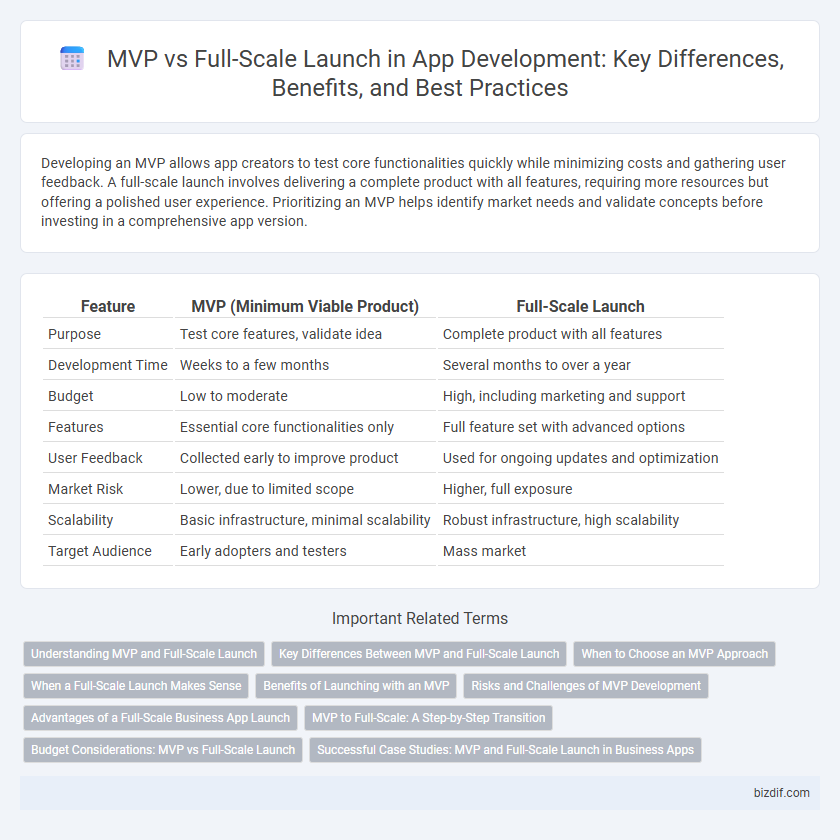Developing an MVP allows app creators to test core functionalities quickly while minimizing costs and gathering user feedback. A full-scale launch involves delivering a complete product with all features, requiring more resources but offering a polished user experience. Prioritizing an MVP helps identify market needs and validate concepts before investing in a comprehensive app version.
Table of Comparison
| Feature | MVP (Minimum Viable Product) | Full-Scale Launch |
|---|---|---|
| Purpose | Test core features, validate idea | Complete product with all features |
| Development Time | Weeks to a few months | Several months to over a year |
| Budget | Low to moderate | High, including marketing and support |
| Features | Essential core functionalities only | Full feature set with advanced options |
| User Feedback | Collected early to improve product | Used for ongoing updates and optimization |
| Market Risk | Lower, due to limited scope | Higher, full exposure |
| Scalability | Basic infrastructure, minimal scalability | Robust infrastructure, high scalability |
| Target Audience | Early adopters and testers | Mass market |
Understanding MVP and Full-Scale Launch
An MVP (Minimum Viable Product) serves as the initial version of an application designed to validate core functionalities and gather user feedback with minimal development resources. In contrast, a full-scale launch includes comprehensive features, rigorous testing, and scalable infrastructure aimed at delivering a complete user experience. Prioritizing MVP development accelerates market entry, reduces risks, and informs iterative improvements before committing to a full product release.
Key Differences Between MVP and Full-Scale Launch
MVP (Minimum Viable Product) focuses on delivering core features to validate market demand quickly with minimal resources, while a full-scale launch includes a comprehensive feature set designed for a broad audience and long-term use. MVP development emphasizes rapid iteration, user feedback, and risk mitigation, whereas full-scale launches prioritize scalability, robustness, and user experience refinement. Key differences include development time, cost, feature scope, and market readiness, with MVPs serving as a testing phase before committing to the full product lifecycle.
When to Choose an MVP Approach
Choosing an MVP approach is ideal when market uncertainty is high and quick user feedback is essential for validating core product concepts. It reduces initial development costs by focusing on essential features, allowing developers to iterate rapidly based on real user data. Startups and businesses aiming to minimize risk and test product-market fit often benefit most from launching an MVP before committing to a full-scale app.
When a Full-Scale Launch Makes Sense
A full-scale launch makes sense when market validation through the MVP phase confirms strong user demand and product-market fit, reducing the risk of failure. Companies with sufficient resources and a clear competitive advantage benefit from investing in a polished, feature-rich app to capture market share quickly. Scaling server infrastructure, customer support, and marketing efforts aligns with a full-scale launch to ensure seamless user experience and growth momentum.
Benefits of Launching with an MVP
Launching with a Minimum Viable Product (MVP) accelerates time-to-market by allowing developers to test core functionalities and gather real user feedback early. This approach reduces development costs and mitigates risks by validating assumptions before investing in full-scale features. Prioritizing MVP enables iterative improvements, ensuring the final app aligns closely with market needs and user expectations.
Risks and Challenges of MVP Development
MVP development carries significant risks including limited feature sets that may fail to meet user expectations, leading to poor market validation and potential brand damage. Challenges include balancing minimal functionality with sufficient usability to attract early adopters while managing constrained budgets and tight timelines. Inadequate user feedback or rushed iterations during MVP phases can delay full-scale launch and increase overall development costs.
Advantages of a Full-Scale Business App Launch
A full-scale business app launch provides comprehensive functionality and a polished user experience, enhancing customer satisfaction and retention. It supports scalability and robust performance, accommodating higher user volumes and complex features without compromising stability. This approach also maximizes market impact and brand credibility by delivering a fully realized product that meets diverse customer needs from the outset.
MVP to Full-Scale: A Step-by-Step Transition
Launching an MVP (Minimum Viable Product) allows app developers to validate core features and gather user feedback efficiently before investing in a full-scale launch. Transitioning from MVP to full-scale involves iterative testing, feature enhancement based on analytics, and scalability improvements to meet growing user demands. This step-by-step approach minimizes risk, optimizes resource allocation, and ensures product-market fit for sustainable app growth.
Budget Considerations: MVP vs Full-Scale Launch
Budget considerations significantly impact the decision between developing a Minimum Viable Product (MVP) and proceeding with a full-scale launch. MVPs require lower initial investment, allowing startups to validate ideas and gather user feedback with minimal financial risk. In contrast, full-scale launches demand substantial funding to cover comprehensive features, extensive testing, marketing, and infrastructure, which can strain resources if market demand is uncertain.
Successful Case Studies: MVP and Full-Scale Launch in Business Apps
Successful case studies in app development highlight the strategic advantage of launching an MVP to validate business ideas and gather user feedback, significantly reducing time-to-market and development costs. Full-scale launches build on MVP insights, incorporating comprehensive features and robust performance to meet broader market demands and drive user retention. Businesses like Airbnb and Dropbox exemplify this approach, initially deploying MVPs to test viability before scaling into full-featured applications that sustained long-term growth and competitive advantage.
MVP vs Full-scale launch Infographic

 bizdif.com
bizdif.com